Standard [CURRENT]
ASTM E 1606:2025
Standard Practice for Electromagnetic (Eddy Current) Examination of Copper and Aluminum Redraw Rod for Electrical Purposes
- German title
- Elektromagnetische (Wirbelstrom) Untersuchung von Kupfer- und Aluminiumdrahtvormaterial für elektrotechnische Zwecke
- Publication date
- 2025
- Original language
- English
- Pages
- 5
- Publication date
- 2025
- Original language
- English
- Pages
- 5
- DOI
- https://dx.doi.org/10.1520/E1606-25
Product information on this site:
Quick delivery via download or delivery service
Buy securely with a credit card or pay upon receipt of invoice
All transactions are encrypted
Short description
1.1 This practice covers the procedures that shall be followed in electromagnetic (eddy current) examination of copper and aluminum redraw rods for detecting discontinuities or imperfections of a severity likely to cause failure or markedly impair surface quality of the rod. These procedures are applicable for continuous lengths of redraw rod in diameters from 1/4 in. to 13/8 in. (6.4 mm to 35 mm) suitable for further fabrication into electrical conductors. 1.2 This practice covers redraw rod made from tough-pitch or oxygen-free coppers. It can also be used for other types of copper, such as fire-refined high conductivity rod. It is also appropriate for aluminum and other nonferrous alloys used for electrical purposes. 1.3 The procedures described in this practice are based on methods for making use of differential or absolute stationary encircling annular test coil systems. 1.4 This practice does not establish acceptance criteria. Acceptance criteria must be established by the using parties. 1.5 Units- The values stated in inch-pound units are to be regarded as standard. The values given in parentheses are mathematical conversions to SI units that are provided for information only and are not considered standard. 1.6 This standard does not purport to address all of the safety concerns, if any, associated with its use. It is the responsibility of the user of this standard to establish appropriate safety, health, and environmental practices and determine the applicability of regulatory limitations prior to use. 1.7 This international standard was developed in accordance with internationally recognized principles on standardization established in the Decision on Principles for the Development of International Standards, Guides and Recommendations issued by the World Trade Organization Technical Barriers to Trade (TBT) Committee.
ICS
29.050
DOI
https://dx.doi.org/10.1520/E1606-25
Also available in
Loading recommended items...
Loading recommended items...
Loading recommended items...
Loading recommended items...

